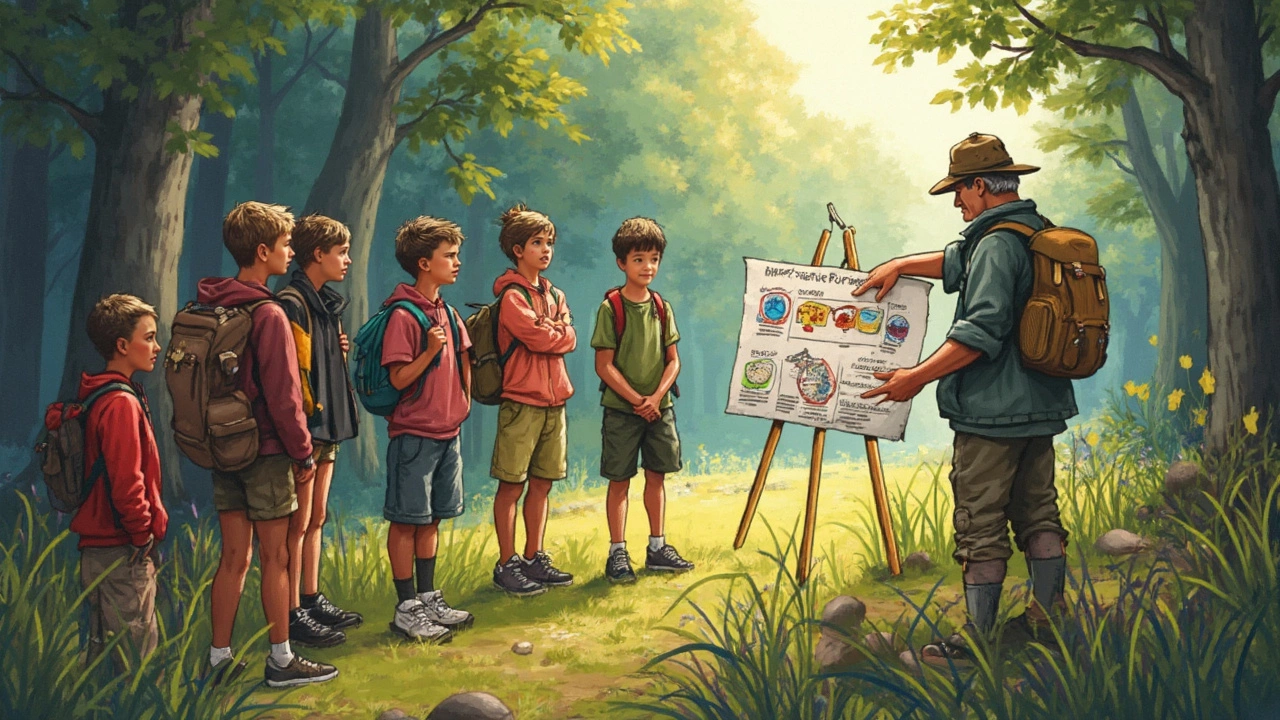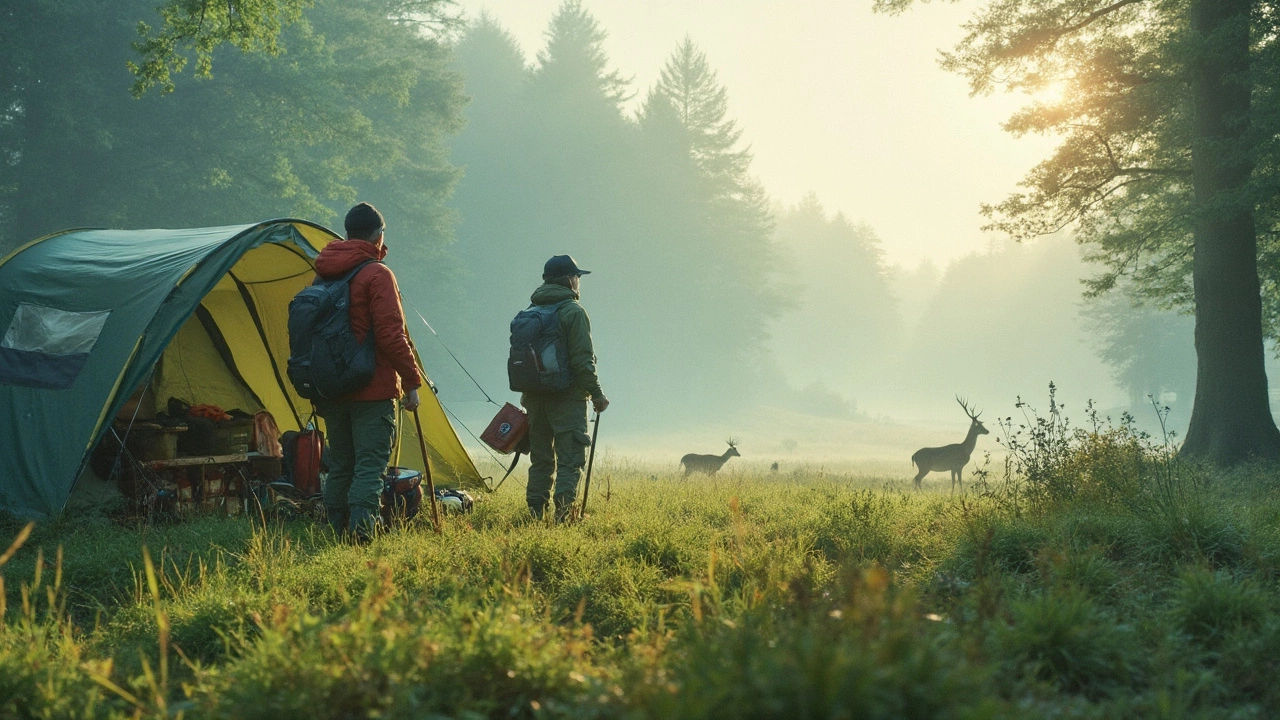You ever head out into the wild, ready to soak in nature, and then realize you left a trail of chaos? Yeah, we've all been there. The golden rule we should all follow when camping? Leave no trace. It's not just about being tidy, it's about making sure the great outdoors stays great, especially if you're pitching your tent near one of those enchanting eco-friendly cottages.
Setting up camp is a blast, no doubt, but it comes with responsibility. Think of packing like planning a road trip with an OCD friend – only take what you need, and choose gear that's eco-friendly. Reusable containers and biodegradable soap, anyone? These little changes pile up into big eco wins!
- Understanding Leave No Trace
- Packing Essentials for Eco-Conscious Camping
- Choosing the Right Campsite
- Minimizing Campfire Impact
- Respecting Wildlife and Their Habitat
- Sustainable Camping Tips for Families
Understanding Leave No Trace
Alright, so you're all hyped up about camping, but there’s this one golden rule you need to know: Leave No Trace. Think of it as your guide to being a top-notch eco-friendly camper. It's not just about cleaning up after yourself; it's about being a guardian of nature, making sure you're not leaving any footprint, literally and metaphorically.
The Leave No Trace Center for Outdoor Ethics spells out seven principles that help outdoor lovers like us preserve the natural wonders for future adventurers. Let's break them down:
- Plan Ahead and Prepare: Equip yourself with knowledge of the area. Check weather conditions, rules, and regulations. And yeah, make sure your gear is both weather-appropriate and environmentally friendly.
- Travel and Camp on Durable Surfaces: Stick to marked trails and campsites. When you're off-road, think about durable surfaces like rocks or gravel where your foot traffic won't cause harm.
- Dispose of Waste Properly: This one's huge. Pack out all trash, leftover food, and litter. What you brought in should go out with you.
- Leave What You Find: Resist the urge to snag a keepsake. Leave rocks, plants, and historical artifacts just as they are.
- Minimize Campfire Impact: Campfires are great, but use a lightweight stove for cooking if you can. If you do make a fire, ensure it's small, controlled, and use established fire rings.
- Respect Wildlife: Observe animals from a distance and never feed them. This preserves their natural habits and keeps you safe.
- Be Considerate of Other Visitors: Keep noise levels low and be mindful of those around you. Everyone deserves a peaceful nature experience.
Here's a small nugget of info: The Leave No Trace program has been backed by the National Park Service and thousands of parks globally, which shows just how important it is. So next time you're planning a trip, remember these principles not just to follow rules, but to be an all-star protector of nature.
Packing Essentials for Eco-Conscious Camping
Alright, let's talk about packing smart and keeping nature happy. When you're heading out for a camping trip, what you bring—and what you leave behind—matters a lot. The first step is a solid pack, sturdy but not overly bulky, made from sustainable materials if you can swing it.
Start with the basics. Go for reusable gear wherever possible. Think stainless steel water bottles, bamboo utensils, and lightweight pots and pans. These not only reduce waste but also are often more durable than their disposable counterparts. For storage, use reusable bags instead of plastic ones. Packing hacks like this keep the environment clean and your pack organized.
Remember the critical items:
- Tent and sleeping bags made from eco-friendly materials. Many brands now offer products made from recycled fibers. Bonus: look for ones that are light and easy to carry without heavy packaging.
- Biodegradable soap and personal care items. These are gentle on the land and your skin, making them a great double win.
- Solar-powered gadgets. From lanterns to chargers, using solar energy instead of traditional batteries cuts down on waste and keeps your devices running green.
- A portable stove can be a better option for cooking than a campfire, reducing impact on the forest floor.
Also, bring trash bags of different sizes. Trust me, these are your best friends for maintaining the leave no trace principle. Separate waste from recyclables and never leave anything behind.
If you're camping with family, especially with kids, involve them in the packing process. Make it a game to find eco-friendly alternatives. Not only is it educational, but it also makes them more conscious of their choices.
Choosing the Right Campsite
Picking the perfect spot is a bit like finding your favorite coffee shop – cozy, safe, and leaving you feeling good. First off, think about how to minimize your impact on nature around you. Always choose already impacted sites when available. This helps protect fresh, untouched nature from damage.
When looking for a camping site, aim for at least 200 feet away from lakes and streams to protect the riverbanks and water quality. Plus, it saves you from any midnight flooding drama. Aim for flat ground, unless you fancy rolling out of your sleeping bag. Pro tip: look for durable surfaces like rock, sand, or dry grass instead of squishy, wet ground.
Always check local rules and restrictions. Some places have specific areas set aside for camping to protect wildlife and habitats. A great resource mentioned by the National Park Service is:
"Choosing a campsite with existing fire pits and cleared areas helps preserve the natural landscape for generations to come."
Here's a quick checklist to help you find that perfect spot:
- Is the area 200 feet from water sources?
- Does it have an existing fire pit?
- Is the ground level and sturdy?
- Check for overhanging branches that might cause trouble in a storm.
- Be aware of animal trails – no one wants surprise guests in the night!
Remember, the right campsite means you can enjoy your adventure without giving Mother Nature a headache. Settling into a spot that respects the land makes it easier for the environment to bounce back after your visit.

Minimizing Campfire Impact
Ah, campfires. They're the heart of every camping trip, right? I mean, what’s camping without roasting marshmallows? But they can cause a mess if we're not careful. You don’t want to be that person who leaves behind a scorched earth or, worse, ignites a wildfire.
First off, check if fires are allowed where you’re camping. Some areas have seasonal restrictions because of fire hazards. It's wise to pack a small camping stove as a backup. If campfires are a go, pick an existing fire ring instead of creating new ones. This keeps the ground from looking like Swiss cheese!
Keep your fire small. Nobody needs a bonfire that rivals Burning Man. Use only sticks and wood found on the ground—never chop down trees. It'll save you from a hefty fine and give a tree hugger a heart attack. Make sure you use local wood to prevent introducing pests to new areas. Leave the firewood at home, folks!
To really rock the eco-friendly vibe, always fully extinguish your fire before turning in or heading out. Pour water until the hissing stops, stir the ashes, then water again. If you can touch the ashes without getting burned, you’ve done it right.
Worried about the sustainability of your campfire? Imagine this: reducing carbon emissions is like taking 1.9 million cars off the road yearly. So, achieving the perfect balance between enjoying your smores and saving the planet is totally doable.
- Check for fire regulations in your area.
- Use existing fire rings whenever possible.
- Keep it small and manageable.
- Extinguish it completely before leaving.
By minimizing your campfire impact, you’re not just being responsible—you’re setting an example. Whether you’re a seasoned outdoor enthusiast or just on a quick getaway, these tips keep our wilderness areas pristine for the next adventures.
Respecting Wildlife and Their Habitat
Exploring the wild is awesome, right? But here's the thing: it's home to many critters and creatures who weren't exactly looking for new neighbors. So, when you're out there, it's crucial to keep our impact in check. Start by keeping a respectful distance from animals. Even if that squirrel seems like it wants a piece of your sandwich, feeding wildlife can really mess with their diets and habits.
Why's this important? Well, giving human food to animals can harm them or make them too dependent on us. Plus, some foods can actually be toxic to our furry and feathered friends.
Another solid tip is to stick to marked trails. It seems simple, but it prevents damage to fragile habitats and stops us from trampling through animals' living rooms. If you spot an animal, observe quietly and avoid making loud noises; they're not fans of surprise parties.
Also, if you're setting up a camp, pitch your tent away from any animal trails or water sources. Animals need these paths and watering holes for survival. Imagine someone blocking your access to the fridge late at night – not cool, right?
Lastly, remember to pack out all waste. This isn’t just about litter. Other waste, like gray water from washing dishes, should be disposed of at least 200 feet from lakes and streams to avoid contaminating water sources.
By keeping these eco-friendly principles in mind, you're not just enjoying nature – you're helping protect it for all the creatures who call it home. And honestly, that's a win for everyone.
Sustainable Camping Tips for Families
Going camping with kids? It's a whole different ball game! Here’s how you can make it an eco-friendly adventure while ensuring your little explorers have a memorable time. First off, involve them in the trip planning. Kids love to feel important, and it’s a great teaching opportunity about the eco-friendly ways of enjoying nature.
Camping Tips for families start with packing right. Bring gear that's reusable and durable. Prioritize items like stainless steel water bottles and collapsible silicone cups over disposable ones. Not only are these options better for the planet, but they're also more rugged for family adventures.
Now, when it comes to food – a key part of any trip, especially for kids – think of packing meals that require minimal packaging. Homemade trail mix in reusable bags is a hit, and consider prepping meals that don't leave behind wasteful debris, like peelable fruits and vegetables.
When setting up camp, teach your kids the importance of choosing a legal and established campsite. Not every patch of dirt is fair game, and designated spots help minimize our impact. If you're up for it, have them help with setting up in a way that leaves the spot just like you found it.
Let's talk campfires. They’re fun but can be tricky when trying to minimize environmental impact. Instead of gathering firewood from the area, consider a portable stove. They’re super handy and reduce the strain on local resources. And hey, it’s a great chance to teach kids about fire safety!
Don’t forget to respect the locals – the wildlife, that is. Kids have a natural curiosity about animals. Encourage them to observe, not disturb. Carry a mini guidebook if your kids love identifying what's out there.
Here's a bonus: get the kids involved in a fun eco activity like a mini-trash collection contest. Make it into a game to see who can gather the most litter (just be sure they're using gloves!). Not only does it clean up the place, but it also ingrains good habits.
Check out this quick look at the impact:
| Item | Traditional Use | Eco-Friendly Alternative |
|---|---|---|
| Plastic Water Bottle | Single-use | Stainless Steel Bottle |
| Disposable Plates | Single-use | Biodegradable/Reusable Plates |
| Plastic Bags | Single-use | Cloth/Recyclable Bags |
Follow these tips, and soon, you’ll have a family of seasoned eco warriors who know that nature conservation is part of camping fun!
